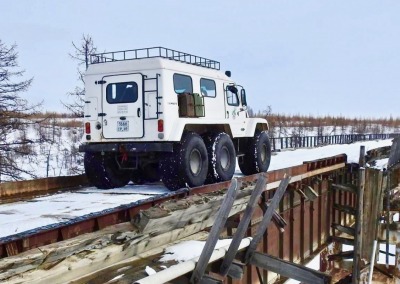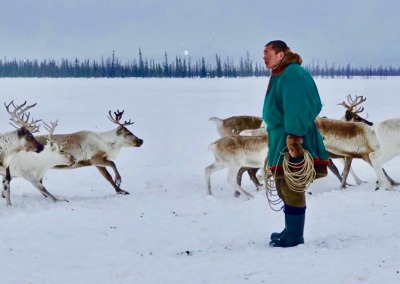Polar Ural Mountains
The Ural Mountains run from Kazakhstan to the southern Yamal Peninsula. They form the geographical border between Europe and Asia. The Polar Urals, the northernmost part of the Ural mountain chain, thus form the boundary between the European and Asian Arctic. The Yamal-Nenets Autonomous Region forms the Asian side of the border, while the European side is made up of the confusingly-named Nenets Autonomous Region in the north and the Komi Republic in the south. The European side also has nomadic reindeer herders, of course, and we offer tours there on our sister site Arctic Russia Travel. However, in general they are less migratory than the Yamal Peninsula Nenets and have preserved their traditional way of life less well.
We offer tours to stay with nomadic reindeer herders in the Polar Ural Mountains on the Asian side (the side in the Yamal-Nenets Autonomous Region) both in summer and winter. In winter these tours take place in the area covered by the pricing and itinerary in our Budget program (see below). The reindeer herders are located one day’s easy travel from Salekhard town. In summer they are camped further away and the bigger, more interesting herds take longer to reach. They are covered by the pricing and itinerary in our Summer Migration program (see below).
The nomads camped there in winter are completely different from those camped there in summer. In winter all the nomads to be found in Yamal’s Polar Urals are in fact Nenets from the European side of the border. In summer they are camped in Europe but in winter they are camped in Asia!
In summer, in Yamal’s Polar Urals, there are a few very small camps of Nenets who winter not far from Salekhard town. However, the majority of the reindeer herders to be found in Yamal’s Polar Urals in summer (and the only really big herds) are not Nenets but Komi and Khanty, who winter to the south and east of Salekhard. Some of them even continue migrating west to spend the summer in Europe! Komi and Khanty people are ethnically and linguistically totally separate from the Nenets. Most of them are sedentary hunters and fishermen. However, some of the most northern groups picked up nomadic reindeer herding from the Nenets. These are the ones you may meet in Yamal’s Polar Ural Mountains in summer.
The main attraction of these trips is the fact that they take place in the mountains. Some encampments are to be found in the foothills while others are right up high amid the peaks. However, for those seeking a fully preserved traditional way of life, the Polar Ural Mountains may not be the best option for several reasons:
- You are unlikely to see anything connected to the traditional religion of the nomads (idols, sacred sites, sacred sledge, sacred sledge pole). This is because most of the European Nenets who are camped there in winter have converted to Christianity and the Khanty and Komi have
not preserved their traditional beliefs quite as well as the Yamal Peninsula Nenets.
- These nomads migrate less often than the Yamal Peninsula Nenets. If migrating with the Nenets is your priority, you are better of visiting the highly migratory Yar-Sale Nenets.
- Certain other traditions have not been quite as well preserved as on the Yamal Peninsula. For example the traditional way to slaughter a reindeer is to face it towards the East, tie a rope around its neck and to strangle it with one man pulling on each end of the rope while silently praying to himself. In the Polar Ural Mountains most camps simply use a knife.
In winter some of the nomad camps to be found in Yamal’s Polar Ural Mountains belong to the so-called Yamb-To Nenets. During the Soviet Union, these were the only nomads in the whole of Russia who migrated in regions so remote from civilisation that they managed to avoid being registered and collectivised. They remained independent throughout the history of the Soviet Union, without money, without documents, without education and without knowledge of the Russian language. Finally in 1995 they received internal passport ID documents. However, many of them still do not go to school or speak Russian.
As exciting as this sounds, potential visitors should bear one thing in mind: 75% of the Yamb-To Nenets were converted to Christianity in the 19th Century. Missionaries were very active in the Vorkuta area of the European Russian Arctic. They even translated the Bible into Nenets language, using the name of the Nenets’ main god “Num” as a translation for “God”. Thus guests of most Yamb-To Nenets will not see anything connected to traditional Nenets religion.
We have experience with both the converted and unconverted Yamb-To Nenets. The converted ones we stayed with spoke no Russian but were extremely good, kind people. They read grace from their Nenets language bible prior to every meal in their chum (reindeer-fur teepee).
The unconverted Yamb-To Nenets we visited also spoke no Russian and behaved in a very wild, aggressive way. We left as soon as possible. I expect we were just unlucky and not all of them are like that. However, that was the only time we have ever visited unconverted Yamb-To Nenets. We would also like to stress that this behaviour was certainly not typical of unconverted Nenets. All our Yar-Sale and Seyakha trips are to unconverted Nenets and they are among the most hospitable people on the planet.
Another attraction of the Polar Ural Mountains is of course, in summer, to do some trekking and rafting through this spectacular scenery. Both trekking and rafting trips can be combined with visits to spectacular glaciers, waterfalls, gulag camps, abandoned villages, former rocket launching sites and nomadic encampments. Please get in touch for details.
The Ural Mountains run from Kazakhstan to the southern Yamal Peninsula. They form the geographical border between Europe and Asia. The Polar Urals, the northernmost part of the Ural mountain chain, thus form the boundary between the European and Asian Arctic. The Yamal-Nenets Autonomous Region forms the Asian side of the border, while the European side is made up of the confusingly-named Nenets Autonomous Region in the north and the Komi Republic in the south. The European side also has nomadic reindeer herders, of course, and we offer tours there on our sister site Arctic Russia Travel. However, in general they are less migratory than the Yamal Peninsula Nenets and have preserved their traditional way of life less well.
We offer tours to stay with nomadic reindeer herders in the Polar Ural Mountains on the Asian side (the side in the Yamal-Nenets Autonomous Region) both in summer and winter. In winter these tours take place in the area covered by the pricing and itinerary in our Budget program (see below). The reindeer herders are located one day’s easy travel from Salekhard town. In summer they are camped further away and the bigger, more interesting herds take longer to reach. They are covered by the pricing and itinerary in our Summer Migration program (see below).
The nomads camped there in winter are completely different from those camped there in summer. In winter all the nomads to be found in Yamal’s Polar Urals are in fact Nenets from the European side of the border. In summer they are camped in Europe but in winter they are camped in Asia!
In summer, in Yamal’s Polar Urals, there are a few very small camps of Nenets who winter not far from Salekhard town. However, the majority of the reindeer herders to be found in Yamal’s Polar Urals in summer (and the only really big herds) are not Nenets but Komi and Khanty, who winter to the south and east of Salekhard. Some of them even continue migrating west to spend the summer in Europe! Komi and Khanty people are ethnically and linguistically totally separate from the Nenets. Most of them are sedentary hunters and fishermen. However, some of the most northern groups picked up nomadic reindeer herding from the Nenets. These are the ones you may meet in Yamal’s Polar Ural Mountains in summer.
The main attraction of these trips is the fact that they take place in the mountains. Some encampments are to be found in the foothills while others are right up high amid the peaks. However, for those seeking a fully preserved traditional way of life, the Polar Ural Mountains may not be the best option for several reasons:
- You are unlikely to see anything connected to the traditional religion of the nomads (idols, sacred sites, sacred sledge, sacred sledge pole). This is because most of the European Nenets who are camped there in winter have converted to Christianity and the Khanty and Komi have not preserved their traditional beliefs quite as well as the Yamal Peninsula Nenets.
- These nomads migrate less often than the Yamal Peninsula Nenets. If migrating with the Nenets is your priority, you are better of visiting the highly migratory Yar-Sale Nenets.
- Certain other traditions have not been quite as well preserved as on the Yamal Peninsula. For example the traditional way to slaughter a reindeer is to face it towards the East, tie a rope around its neck and to strangle it with one man pulling on each end of the rope while silently praying to himself. In the Polar Ural Mountains most camps simply use a knife.
In winter some of the nomad camps to be found in Yamal’s Polar Ural Mountains belong to the so-called Yamb-To Nenets. During the Soviet Union, these were the only nomads in the whole of Russia who migrated in regions so remote from civilisation that they managed to avoid being registered and collectivised. They remained independent throughout the history of the Soviet Union, without money, without documents, without education and without knowledge of the Russian language. Finally in 1995 they received internal passport ID documents. However, many of them still do not go to school or speak Russian.
As exciting as this sounds, potential visitors should bear one thing in mind: 75% of the Yamb-To Nenets were converted to Christianity in the 19th Century. Missionaries were very active in the Vorkuta area of the European Russian Arctic. They even translated the Bible into Nenets language, using the name of the Nenets’ main god “Num” as a translation for “God”. Thus guests of the Yamb-To Nenets will not see anything connected to traditional Nenets religion.
We have experience with both the converted and unconverted Yamb-To Nenets. The converted ones we stayed with spoke no Russian but were extremely good, kind people. They read grace from their Nenets language bible prior to every meal in their chum (reindeer-fur teepee).
The unconverted Yamb-To Nenets we visited behaved in a very wild, aggressive way. We left as soon as possible. I expect we were just unlucky and not all of them are like that. However, that was the only time we have ever visited unconverted Yamb-To Nenets. We would also like to stress that this behaviour was certainly not typical of unconverted Nenets. All our Yar-Sale and Seyakha trips are to unconverted Nenets and they are among the most hospitable people on the planet.
Another attraction of the Polar Ural Mountains is of course, in summer, to do some trekking and rafting through this spectacular scenery. Both trekking and rafting trips can be combined with visits to spectacular glaciers, waterfalls, gulag camps, abandoned villages, former rocket launching sites and nomadic encampments. Please get in touch for details.


